Where to dig in?
You’ll get the best results by choosing the best fertilizer for grass based on your specific lawn needs and soil conditions. For quick greening, try synthetic options like Scotts Turf Builder 32-0-4, which delivers fast results through readily available nutrients. If you prefer long-term soil health, organic fertilizers like Milorganite 6-4-0 work slower but improve soil structure and create safer conditions for pets. Most lawns thrive with 3-1-2 or 4-1-2 NPK ratios, though a soil test reveals your yard’s specific nutrient requirements and ideal application strategies.
Types of Grass Fertilizers and Their Benefits
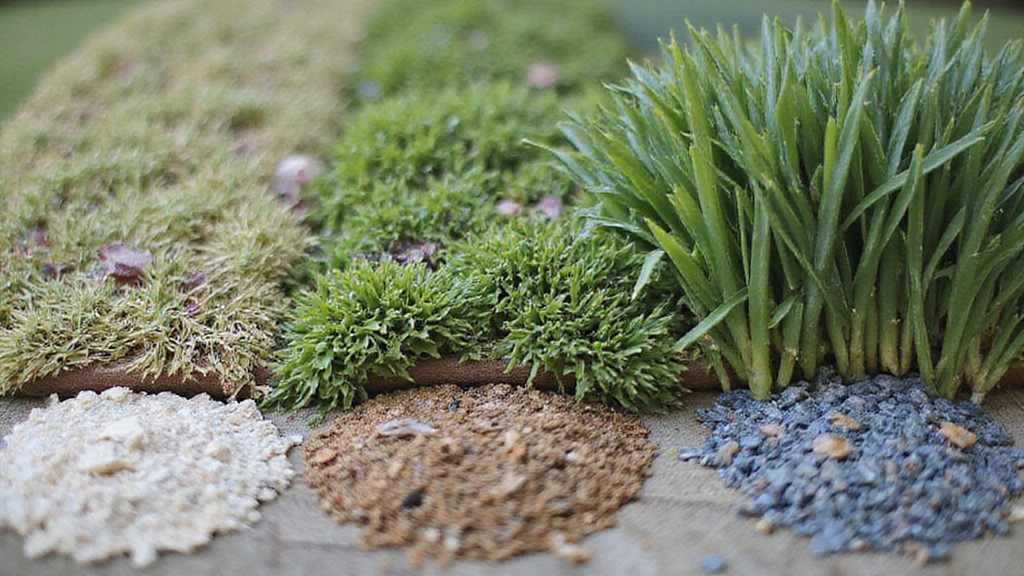
When you’re selecting the best fertilizer for your grass, understanding the different types available will help you make an informed decision that benefits both your lawn and your budget.
Synthetic vs. Organic Options
Synthetic fertilizers deliver quick results through chemical-based nutrients, making them cost-effective and convenient for addressing specific deficiencies. You’ll see faster growth, but they won’t improve your soil’s long-term health.
Organic fertilizers work slower but enhance soil structure, promote beneficial microbes, and create safer conditions for pets and children. They’re more expensive initially, yet provide lasting soil benefits. These organic fertilizers can sometimes include components like kelp meal, which provide a range of beneficial nutrients and support sustainable gardening practices.
Application Methods
Liquid fertilizers absorb quickly into grass roots, giving you fast results for immediate needs. Granular fertilizers release nutrients slowly over months, reducing application frequency while maintaining consistent feeding throughout the growing season. The NPK ratio on fertilizer packages indicates the percentage of nitrogen, phosphorus, and potassium to help you choose the right nutrient balance for your lawn’s specific needs.
Understanding NPK Ratios for Optimal Lawn Health
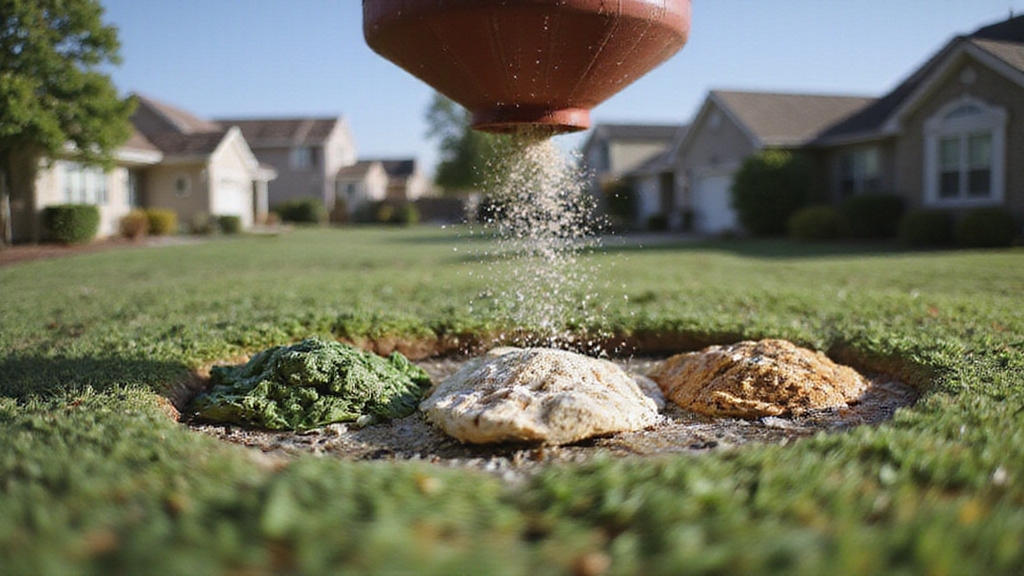
After choosing between synthetic and organic fertilizers, you’ll need to understand the three numbers printed on every fertilizer package. These NPK ratios represent nitrogen, phosphorus, and potassium percentages in your fertilizer.
What Each Number Means
Nitrogen promotes green color and thick growth, while phosphorus strengthens roots and energy transfer. Potassium enhances stress resistance and water balance throughout your lawn. A well-maintained lawn often has similarities to loamy soil due to the balance of nutrients that allows for excellent drainage and moisture retention.
Choosing the Right Ratio
Most lawns thrive with 3-1-2 or 4-1-2 ratios, but you’ll want to conduct a soil test first. This reveals specific nutrient deficiencies in your yard. Understanding these numbers helps ensure a healthy, strong lawn.
Application Guidelines
Timing matters greatly for excellent results. Avoid nitrogen applications after mid-September for warm-season grasses, and always follow local phosphorus regulations in your area.
Top-Rated Fertilizer Products for Every Lawn Need
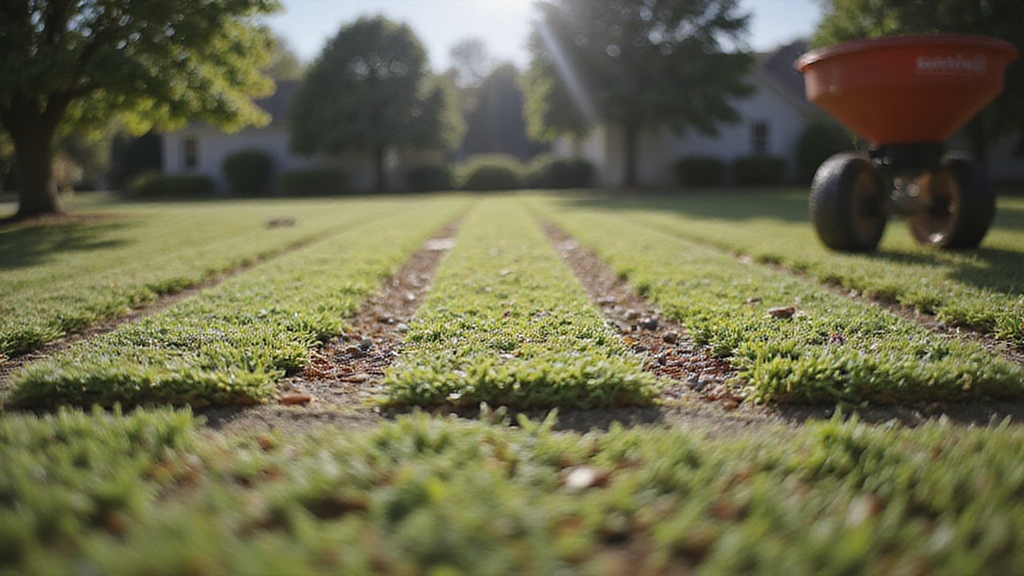
The right fertilizer product can transform your lawn from struggling to spectacular, but finding the perfect match requires understanding your specific grass needs and growing conditions.
Fast-acting granular fertilizers like Scotts Turf Builder 32-0-4 deliver quick greening results, while Ugarit 40-10-10 provides nitrogen-rich nutrition for high-traffic areas. For sustainable lawn care, you’ll benefit from slow-release organic options that feed your grass for weeks without burning. Milorganite 6-4-0 improves soil health naturally, and Safer Brand offers pet-safe formulations.
Modern suspension and gel formulas provide better nutrient delivery with reduced leaching compared to traditional liquid fertilizers. Consider incorporating a product such as Scotts Turf Builder Weed & Feed, which uses WeedGrip Technology to control numerous weeds while fertilizing the lawn. Consider these specialized solutions for specific situations:
Transform your lawn from struggling to spectacular by choosing fertilizers that match your specific grass needs and growing conditions.
- New lawns: Sta-Green 18-24-6 maximizes root development
- Soil enhancement: Ugarit 10-0-5 enriches microorganisms
- Disease protection: Sulforex 60 + Cu prevents fungal infections
Choose products that match your grass type, application timing, and specific lawn challenges.
Organic Vs Synthetic Fertilizers: Making the Right Choice
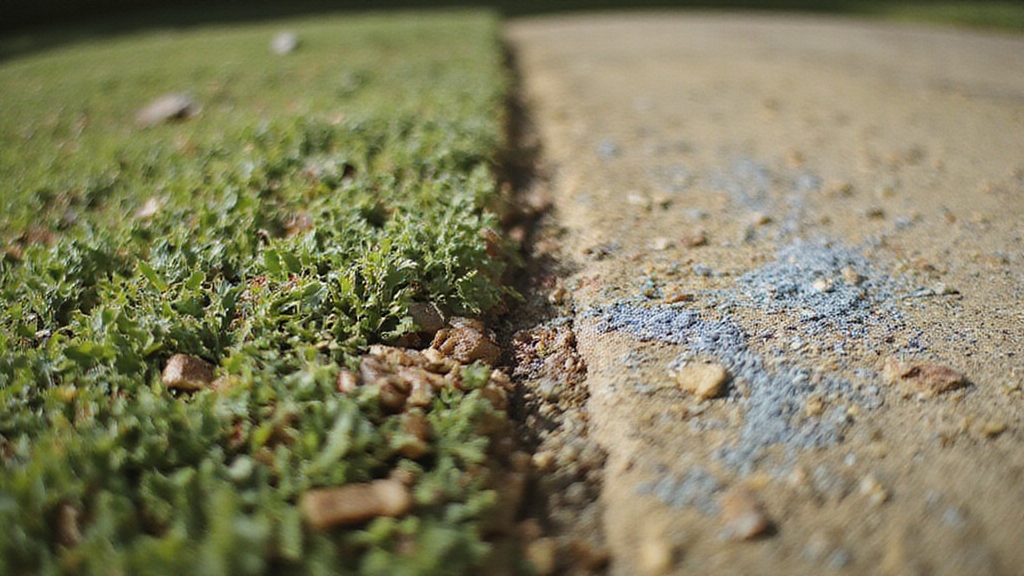
Beyond selecting specific fertilizer products, you’ll need to decide between organic and synthetic formulations, each offering distinct advantages for your lawn’s health and appearance.
Understanding Your Options
Organic fertilizers release nutrients slowly, providing steady nourishment while improving soil structure and microbial life. They’re environmentally friendly but cost more upfront. Before applying fertilizers, consider incorporating manual or chemical weed control methods to manage potential infestations. Synthetic fertilizers deliver rapid results with precise nutrient ratios, making them budget-friendly and convenient for quick fixes.
| Feature | Organic | Synthetic |
|---|---|---|
| Nutrient Release | Slow, steady | Fast, immediate |
| Environmental Impact | Low risk | Higher leaching risk |
| Cost | More expensive | Budget-friendly |
Choose organic fertilizers if you’re focused on long-term soil health and sustainability. Select synthetic options when you need quick results or have budget constraints. However, applying too much synthetic fertilizer can burn lawns and plants, making careful application essential.
Proper Application Timing and Frequency Guidelines
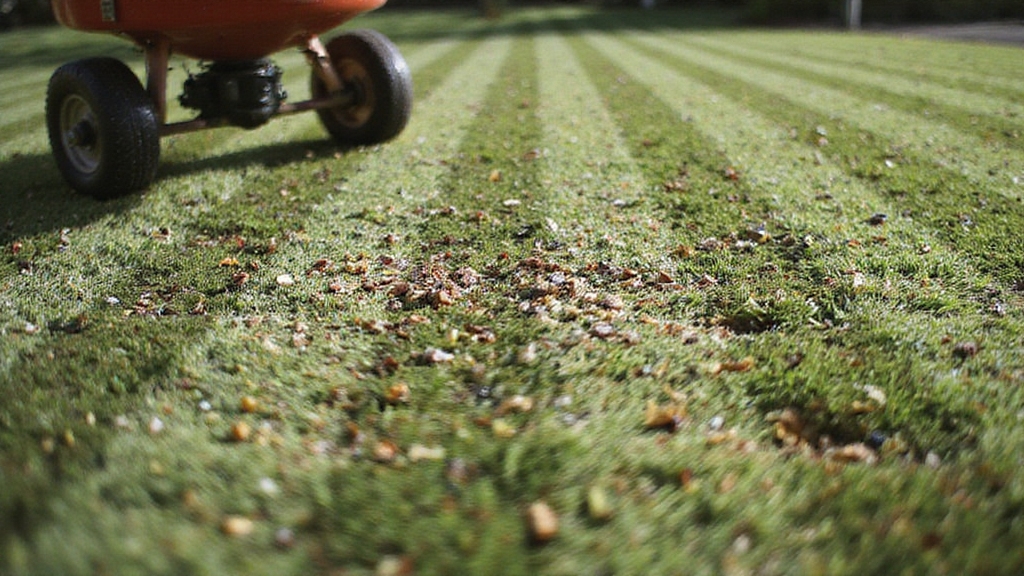
Success with lawn fertilization depends heavily on when and how often you apply nutrients throughout the year. Your grass type determines the ideal schedule, so you’ll need to match your timing to whether you have cool-season or warm-season varieties.
Seasonal Application Guidelines
- Spring/Summer: Apply to cool-season grasses in late spring when temps reach 60°F consistently, warm-season grasses in early summer
- Fall: Most critical period – fertilize 6-8 weeks before first frost to encourage strong root development
- Winter: Only use high-potassium winterizer on cool-season grasses before freeze
Cool-season lawns typically need 3-4 applications yearly, while warm-season grasses require 3-4 feedings between spring green-up and late summer. Always apply during morning or evening hours when temperatures stay between 55-85°F to prevent burning. Your lawn wakes up hungry after winter dormancy, making early spring fertilization essential for strengthening roots and kickstarting healthy growth.
For those dealing with weed control during fertilization, products like Spectracide Weed Stop for Lawns Plus Crab Grass Killer offer selective solutions that won’t harm the grass while targeting weeds.
Safety Considerations and Environmental Impact
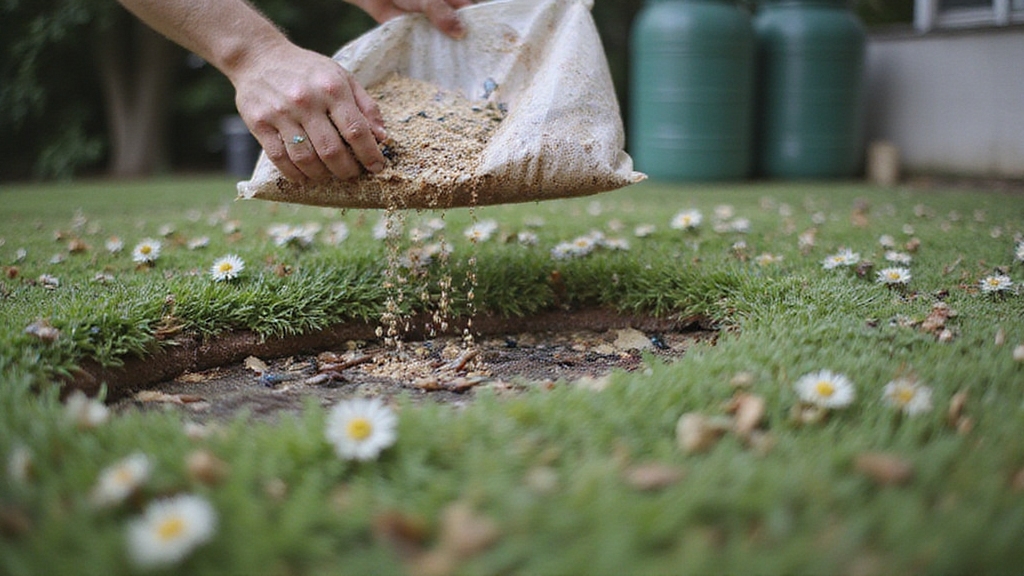
Millions of homeowners apply lawn fertilizers without fully understanding the potential risks these products pose to their families, pets, and local environment. You’re exposed to approximately 80 million pounds of pesticides applied annually across North American lawns and gardens. These chemicals increase cancer risks in dogs, contaminate groundwater supplies, and contribute roughly 25 million tons of CO2 equivalent emissions yearly. Choosing the right compost bin for waste processing can also indirectly support lawn health by providing natural fertilizers.
Manufacturing nitrogen-based fertilizers creates significant environmental costs, producing 4-5 tons of CO2 for every ton of nitrogen generated. Additionally, 40-60% of applied nitrogen fertilizers don’t stay in your soil but instead wash into waterways, causing harmful algal blooms and dead zones.
| Impact Category | Risk Level | Primary Concern |
|---|---|---|
| Pet Health | High | Cancer risk increase |
| Water Quality | Severe | Groundwater contamination |
| Air Quality | Moderate | Greenhouse gas emissions |
| Soil Health | High | Microbial disruption |
| Wildlife | Severe | Ecosystem disruption |
You can reduce these risks by choosing organic fertilizers, leaving grass clippings on your lawn, and switching to native plants that require fewer chemicals.
Frequently Asked Questions
Can I Fertilize My Lawn in Winter or During Dormant Seasons?
You can fertilize your lawn during winter or dormant seasons, and it’s actually beneficial. Apply winter fertilizer after your last fall mow, typically in November. This timing helps your grass store nutrients for spring recovery, improves cold hardiness, and promotes earlier green-up.
Choose fertilizers with potassium for cold protection and nitrogen for late-season color if temperatures allow.
How Much Does Quality Grass Fertilizer Typically Cost per Application?
You’ll typically pay $103 to $343 per application for professional lawn fertilization services, averaging around $289.
For DIY approaches, expect $0.12 to $0.31 per square foot depending on fertilizer type. Synthetic options cost less than organic varieties, while liquid fertilizers run higher at $150 to $600 per quarter-acre.
Annual packages often provide 20-25% discounts, making regular treatments more affordable for consistent lawn care.
What Should I Do if I Accidentally Over-Fertilize My Lawn?
If you’ve over-fertilized your lawn, immediately flush the area with water to dilute excess salts and prevent further damage.
Remove any visible fertilizer granules from the grass surface, then water deeply for several days. Avoid applying more fertilizer until your lawn recovers. Aerate compacted soil to improve water penetration.
Monitor for new green growth, which indicates recovery is beginning.
Can I Mix Different Types of Fertilizers Together for Better Results?
You can definitely mix different fertilizer types for better results. Combining organic and synthetic fertilizers gives you immediate nutrient release plus long-term soil benefits.
The synthetic portion feeds your grass quickly during growth spurts, while organic materials improve soil health and provide steady nutrition. This approach reduces over-application risks, costs less long-term, and creates healthier, more resilient turf.
How Long Should I Wait to Mow After Applying Fertilizer?
You should wait 24-48 hours before mowing after applying fertilizer. For liquid fertilizers, wait 24 hours once the grass is completely dry. Granular fertilizers need more time until pellets fully dissolve and absorb into the soil. Rain helps speed up this process for granular types.
Always check your fertilizer label for specific instructions, and never mow wet grass to prevent clumping and disease spread.
Conclusion
You’ve learned the essentials for choosing the right fertilizer to transform your lawn. Whether you select organic or synthetic options, understanding NPK ratios and proper timing will guarantee success. Remember to follow application guidelines carefully, consider environmental impact, and match your fertilizer choice to your grass type. With consistent care and the knowledge you’ve gained, you’ll achieve the healthy, vibrant lawn you want this season.

